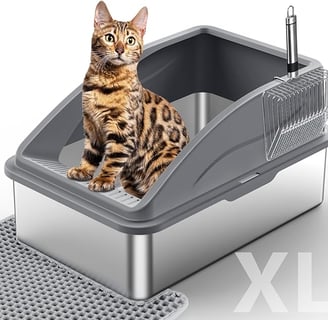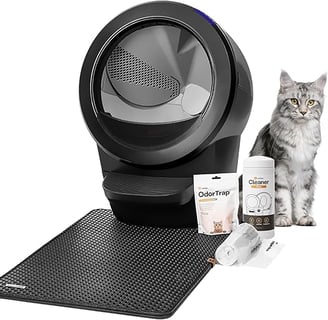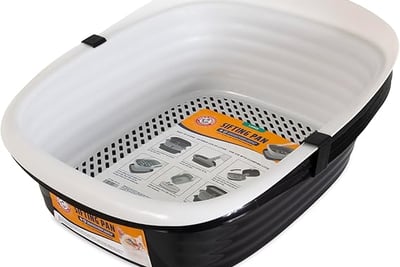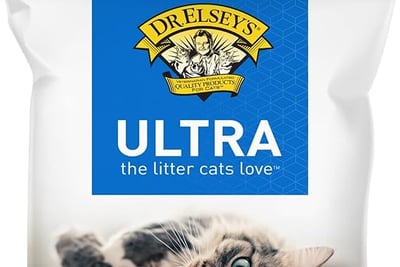The Essential Guide to Cat Litter Boxes
8 min read


Understanding the Importance of Cat Litter Boxes
Cat litter boxes play a fundamental role in maintaining a cat's hygiene, comfort, and overall health. By offering a designated area for cats to relieve themselves, these boxes encourage proper bathroom habits and discourage inappropriate elimination in other areas of the home. This is critical not only for the well-being of the feline but also for the harmony of the household environment.
One significant aspect of cat litter boxes is cleanliness. A well-maintained litter box helps prevent unpleasant odors, which is essential for the comfort of both the cat and its owners. Regular scooping and changing of the litter can greatly reduce foul smells, keeping the home environment more pleasant. Additionally, a clean litter box is more likely to be used by the cat, while a dirty one may lead to aversion and result in accidents throughout the house.
Furthermore, the proper use of a litter box can prevent various health issues for cats. For instance, ignoring litter box cleanliness can lead to urinary tract infections or other health concerns related to improper elimination behaviors. Ensuring that the box is a welcoming and hygienic space encourages the cat to use it consistently, thereby minimizing the risk of such health problems. The psychological comfort provided by a familiar and clean litter box can greatly enhance a cat's well-being.
In summary, the importance of cat litter boxes extends beyond mere convenience; they are vital tools for promoting a cat's health and behavior. By selecting an appropriate litter box and maintaining it properly, cat owners can foster a healthier and more harmonious living environment for their feline friends. Regular attention to the litter box not only supports the cat's hygiene but also contributes to the overall cleanliness of the household, benefitting both pets and their owners alike.
Types of Cat Litter Available in the Market
Choosing the right type of cat litter is essential for both the comfort of your feline friend and the cleanliness of your home. There are several types of litter currently available, each with distinct features, textures, and benefits.
One of the most popular options is clumping clay litter, typically made from bentonite clay. This type forms solid clumps when wet, making it easier to scoop waste and maintain a clean litter box. Clumping clay litter is often favored for its absorbency and odor-control properties. It is well-suited for homes with multiple cats, as it effectively manages waste and reduces odors. However, some users may be concerned about dust production and potential health risks associated with inhaling fine particles.
Non-clumping clay litter, on the other hand, consists of larger granules that do not form clumps. Instead, this type absorbs moisture, requiring more frequent changes to keep the box clean. While it can be less convenient than its clumping counterpart, it might be preferred by cats that are sensitive to dust, as it typically generates less airborne debris.
For environmentally-conscious cat owners, biodegradable litters offer a sustainable alternative. Options such as corn, wheat, and wood-based litters decompose more easily and may have natural odor-absorbing properties. Corn litter, for instance, is made from whole-kernel corn and provides high absorbency, while wheat litter is known for its clumping ability and natural antibacterial properties. Wood-based litters are created from reclaimed wood, producing minimal dust and offering a pleasant scent.
Another type gaining popularity is crystal litter, made from silica gel crystals. This litter absorbs moisture on contact and controls odors effectively, making it low-maintenance. However, it does not provide the same texture as clay litters, which may affect some cats’ preferences.
Understanding the different types of cat litter available can empower cat owners to choose the best option tailored to their pet’s needs, ensuring a comfortable and hygienic environment for all felines involved.
Pros and Cons of Different Types of Cat Litter
When it comes to choosing the right cat litter, it is essential to consider the various types available, each with its unique advantages and disadvantages. Clumping clay litter, for instance, is one of the most popular choices among cat owners due to its ease of cleaning. The clumping action allows for straightforward removal of waste, making it convenient for regular maintenance. However, this type of litter can be dusty, which may pose respiratory concerns for both cats and their owners. Furthermore, when ingested, it could lead to digestive problems, particularly in kittens who are prone to exploring their surroundings with their mouths.
Another alternative is non-clumping clay litter, which absorbs moisture but does not form clumps. It can be less expensive compared to its clumping counterpart and offers decent odor control. Nonetheless, its downside lies in needing more frequent changes, as the litter becomes saturated much faster. This requirement could lead to increased litter usage and may not be the most economical option in the long run.
Biodegradable litters have gained traction as eco-friendly alternatives made from materials such as corn, wheat, or recycled paper. While these options are undeniably better for the environment, they may not always possess strong odor control properties or clumping capabilities. Some users report that these litters tend to break down faster, necessitating regular changes. Additionally, their effectiveness can vary depending on the brand and specific material used.
Finally, crystal litters made from silica gel provide excellent moisture absorption and odor control. They are low in dust and can last longer before needing replacement. However, their cost may be a deterrent for some pet owners, and certain cats may be hesitant to use litter that feels unfamiliar under their paws. Ultimately, understanding these pros and cons will aid cat owners in making informed decisions that best suit their feline friend’s needs and their preferences.
Traditional Litter Boxes: Overview and Benefits
Traditional litter boxes are a ubiquitous choice for cat owners, providing a straightforward and effective means for felines to relieve themselves. They are primarily composed of a simple rectangular or square container that can be either open or covered. These boxes come in various sizes and styles, catering to the diverse needs of different breeds and ages of cats. An open litter box typically features low sides, allowing easy access for kittens and older cats with mobility issues, while covered options provide privacy for the cat and help contain odors and litter scatter.
One of the key benefits of traditional litter boxes is their affordability. Generally, they are less expensive compared to advanced or self-cleaning models, making them accessible for a wide range of budgets. Moreover, traditional boxes do not require complicated mechanisms, resulting in straightforward maintenance. Regular cleaning involves removing used litter and rinsing or wiping down the box, ensuring a hygienic environment for your pet.
When selecting a traditional litter box, size is a crucial consideration. Approximately one and a half times the length of the cat from nose to tail is often recommended for optimal comfort. For multi-cat households, it is advisable to provide one litter box per cat, plus one additional box, to prevent territorial disputes. The choice between open and covered styles may depend on your cat’s personality; some may prefer the security of a covered box, while others may thrive in an open environment where they feel more exposed and safe. Ultimately, understanding your feline friend’s behavior and preferences plays a significant role in determining the most suitable traditional litter box for their needs.
Robotic Litter Boxes: The Future of Cat Hygiene
In recent years, robotic litter boxes have gained significant popularity among pet owners seeking a more efficient solution for maintaining cat hygiene. These innovative devices are designed to automatically clean the litter box after each use, significantly reducing the time and effort required by owners. Robotic litter boxes utilize various mechanisms, such as rotating scoops or vibration sensors, to detect when a cat has used the box, enabling them to perform an automatic cleanup promptly. This not only ensures cleanliness but also helps to minimize odors, creating a fresher environment for both the cat and its owner.
One of the primary benefits of robotic litter boxes is convenience. Cat owners often lead busy lives and regularly cleaning a traditional litter box can quickly become a chore. By investing in a robotic litter box, owners can enjoy extended periods of time without the need for manual scooping and cleaning. Additionally, these devices often come equipped with advanced odor control systems, including carbon filters and covered waste compartments, further enhancing the overall user experience.
However, potential buyers may have concerns regarding the cost of robotic litter boxes, as they often carry a higher price tag than standard litter boxes. It is essential for owners to consider this initial investment against the time saved and the enhanced quality of life it offers both them and their felines. Another common worry is how well a cat may adapt to using such a device. Fortunately, many cats are quite adaptable and can be introduced to the robotic litter box gradually. Owners can place the automated box alongside the traditional box, offering their pets an option before transitioning fully to the new device.
Overall, robotic litter boxes represent a significant advancement in cat hygiene, providing an efficient, convenient, and effective solution for pet owners. The incorporation of these technological innovations reflects a growing trend towards improved pet care solutions that cater to the needs of both the animal and the owner.
Comparing Traditional and Robotic Litter Boxes: Pros and Cons
When it comes to choosing a litter box, pet owners are often torn between traditional and robotic options. Each type has its respective advantages and disadvantages, making it essential to analyze these factors to determine the best fit for both cat and owner. Traditional litter boxes are typically more affordable, easier to set up, and straightforward to use. They consist of a simple enclosed or open design where cat litter is manually added and cleaned. Although these boxes require regular scooping, most cat owners are accustomed to this routine, which may not pose a significant challenge.
On the other hand, robotic litter boxes offer a more modern solution that automates waste removal. These devices can significantly reduce the frequency of maintenance, as they are designed to sift through litter automatically, separating waste from clean litter. This automation provides greater convenience for busy pet owners. Nonetheless, the initial cost of robotic litter boxes tends to be higher than traditional options, and they may require more technological understanding to operate properly. Additionally, some cats might take time to adapt to the mechanical noises and movements associated with these devices.
When comparing both options, it is crucial to consider the cat's experience as well. While some felines may readily embrace the cleanliness and convenience of a robotic box, others may be hesitant to use a box that they perceive as foreign or intimidating. Transitioning from one type to another might require some patience and encouragement from owners. In assessing the pros and cons of traditional and robotic litter boxes, it becomes apparent that personal preference, budgetary concerns, and the cat's adaptability should all play a significant role in the decision-making process.
Final Thoughts: Choosing the Right Litter and Box for Your Cat
Choosing the right litter and litter box for your cat is a multifaceted decision that requires careful consideration of both your feline friend’s preferences and your own lifestyle needs. One of the first steps is to observe your cat’s behavior in relation to different types of litter. Cats can be quite particular, often displaying clear preferences for specific textures, scents, and materials. For instance, some cats prefer clumping clay litter, while others may gravitate towards natural or biodegradable options. Providing a variety of litter types initially can help determine what your cat finds most comfortable.
When it comes to the litter box itself, size and accessibility are critical factors. A larger litter box can be beneficial for bigger breeds, ensuring sufficient space for your cat to move around comfortably. Furthermore, consider whether opting for a covered or uncovered box aligns with your cat's behavior. Some cats feel secure in covered boxes, while others prefer the openness of uncovered designs. It is also essential to position the litter box in a quiet, low-traffic area where your cat feels safe, as their bathroom habits can be significantly influenced by their environment.
Your budget and values are also important in the selection process. High-quality litter may come at a premium, but it can result in better odor control and less mess, ultimately being more economical in the long run. Additionally, with numerous eco-friendly litter options available, you might find a product that aligns with your values regarding sustainability while ensuring a healthy environment for your cat. By assessing your cat's needs and preferences, alongside your financial parameters, you will be equipped to make an informed choice that promotes your cat's well-being while fitting your lifestyle.











